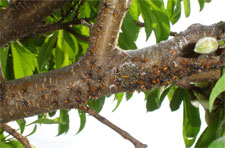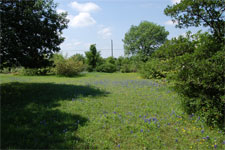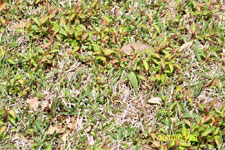Question and Answer May 2010
We’ve gotten tons of questions this month. I have finished the answers as I write this, and I’m not sure I’ll be able to tackle this many in future issues (equivalent to four pages in our magazine). But, I’ll try. I’ll give your question my best shot, but I do ask that you (a) tell me where you live/where the question originates so that I can tailor my answer, and (b) attach a photo of the plant in question. If you don’t have a photo, please call my radio program. Here are this month’s entries.
Question: These little beauties seem to have just hatched on my peach tree. This is a four-year-old tree that really set fruit this year. The last couple of years not much fruit, but the fruit that it does have is always full of sting wounds that are oozing sap. Could these little critters be the culprits? I spray the tree with a product called Fruit Tree Spray. It has captan, malathion and carbaryl. It seems to keep the fungus at bay, but maybe not the bugs. K.D., no city given.
Answer: This one was over my head, so I contacted my longtime "go-to" guy, Dr. Mike Merchant, urban entomologist with the Texas Cooperative Extension. Here is Mike’s reply: (Thanks, Mike!)
"These are probably a species of Leptoglossus, one of our leaf-footed bugs. The body shape is typical of insects in the squash bug family, although the red color is not very squash bug-like. The fact that the eggs are planted en masse shows that the insect is a plant feeder rather than a predator, which would lay its eggs singly or more spread out. These guys are recorded feeding on peaches and other fruits, as well as pecans, vegetables and grains. They feed on the developing seeds or, in this case, pits.
[Such insects are] usually not a big problem. Spot-treat the infestation with soapy water at this stage. Permethrin or Sevin at later stages should work."
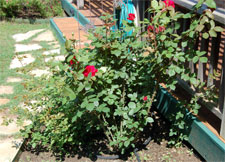
Question: The rose bush in the middle of the picture is the primary rose bush, and the plants on the left by the walk and the small shoot on the right by the deck are both sucker plants off the main bush. I have not seen any blooms on either sucker plant. Will these ever bear flowers, and can they be transplanted or should I just get rid of them? J. W., Aledo.
Answer: These are, as you suggested, suckers, or root sprouts off the original rootstock. The red rose was budded onto the rootstock, so only it will have the flowers you wanted. These suckers will eventually bloom, but only after they overtake and overwhelm the red plant. The sprouts should be removed. Often, their flowers are single and white, resembling those of blackberries. Not anything you’d want.
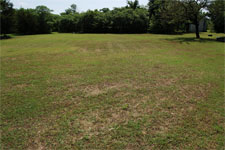
Question: I have a serious bermuda lawn issue. I have been mowing at 1 inch, and I try to keep it watered properly with a traveling sprinkler. However, this year, I’ve been using weedkillers you recommend, but it isn’t looking good. On the bright side, we did have a good crop of bluebonnets. Would corn gluten meal work as a pre-emergent next year? J.W. Aledo.
Answer: I’m a little confused. If this area looked that nice just 2 or 3 weeks ago with the bluebonnets, you must have mowed it recently? The bluebonnet seeds would not have had any time to mature, so most of them will have been lost. Plus, the bluebonnets, grasses, etc., were certainly several inches tall. That works to bermuda’s detriment. You really need to commit to bermuda only, if that’s your goal. Mow it at 1.5 inches constantly. Fertilize it every two months, early April through early October, and keep it moist as much as you can. Weedkillers can be used as needed, but the mowing/fertilization/watering regimen should eliminate their need eventually. Corn gluten meal is not a product I will accept as an advertiser, either on my radio program or in my magazine. I feel very strongly that it is not reliable, and I don’t want to have its poor performance (and listeners’ and readers’ loss of money) on my conscience.
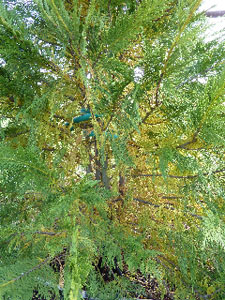
Question: I have recently planted Leyland cypress trees, and they are turning yellow close to the trunk. I am watering them once per week very slowly for about 30 minutes per tree. The soil is definitely a clay mix. Can you tell me what is causing this and how to get them going? C.W., Hunt County.
Answer: This is probably spider mites. The ones that do this damage actually start much earlier than the spider mites we see on tomatoes, beans, marigolds and other summer plants. Thump one of the inner twigs over white paper, and watch for tiny specks to start moving. If they do, those are your culprits. Use a labeled general-purpose insecticide to eliminate them. We no longer have specific miticides available to us. It’s also possible that the trees got too dry at some point, about the time you planted them. If so, keep them moist, and they should recover. The inner needles will drop.
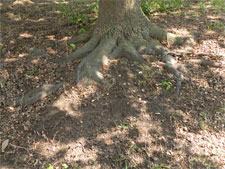
Question: I have two large Shumard red oak trees on the west side of my house. There was a gutter downspout near one of the trees, and the drain water during our wet fall washed away much of the soil from the tree’s roots. This spring we put a drain extension underground and to the side of the tree, so that no more soil would erode. Shall I put topsoil over the roots, and if so, how do I hold the soil? L.H., Highland Village.
Answer: You can fill over the roots if you wish, but you won’t be able to conceal the roots entirely. They’ll still be very near the surface of the soil. If this were my landscape, I’d be creating a serpentine bed slightly outside the area where the shade has killed away the grass, then I would plant a groundcover that could both conceal the roots and stop the erosion. A trailing type like purple wintercreeper would be ideal. In fact, that’s exactly what I’ve used in similar circumstances in my own landscape. Even if you planted St. Augustine, our most shade-tolerant grass, it too would eventually succumb to the shade.
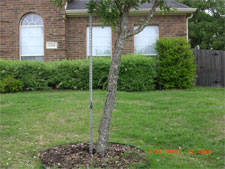
Question: Can you recommend a way that I can straighten this tree? It’s off about 15 degrees. At 3 feet off the ground, it needs to come over by about 8 inches. P.W., Grand Prairie.
Answer: You won’t like my answer, but the only way you will ever be successful in getting this tree straight is to dig it in the winter and to reset it straight. Stake it and guy it tightly in place so that it can’t lean again. Staking it or cabling it without the digging is absolutely futile, even if you leave the support in place for a decade or longer.
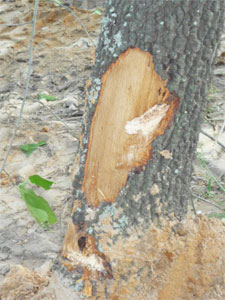
Question: The attached photo shows tree trunk damage to one of our trees on a wooded lot and in sandy soil. The damage was done this week by a backhoe doing a septic system repair job. The chunk out of the tree is about 12 in. in diameter, and the tree trunk is about 18 in. in diameter. Are there any immediate steps we can take to protect the tree, and help in healing? S.K., Athens.
Answer: Carefully trim away loose bark (if any) around the edge of the wound. Do not pull on it, however, since that would risk making it worse. The tree should grow new bark from the sides of the wound. Eventually, in a year or two, the new bark will grow across the wound. If you want to apply a light coat of black pruning sealant, it would help stop any spread of oak wilt through the fresh injury. Otherwise, just wait it out. The tree may struggle a bit this year, especially on the side that was injured. Hopefully, there will be enough bark left intact to allow healing.
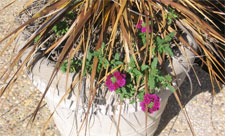
Question: Aren’t verbenas annuals? Look at these that are blooming after such a cold winter. That plant that is dead had lived through many winters, but didn’t survive this year. F., no city given.
Answer: There are as many perennial types of verbenas as there are annuals. The one selected as a Texas SuperStar Plant by Texas A&M is ‘Blue Princess.’ This one looks like it could be that variety.
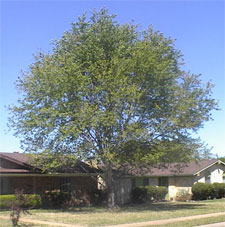
Question: A copper water line, 14-plus inches deep, runs a little over 3 feet from the trunk of this maple tree. Do tree roots growing beside pipes eventually break or smash them, or do the roots encompass the pipes, as it would a cable or wire left around a tree? O.W., Garland.
Answer: I guess there could be reason to be worried, as many roots as there are showing. However, the majority of a tree’s roots are within the top foot of soil, so at 14 inches, there may be no real cause for concern. You could dig carefully to inspect it all if you wished. Honestly, I’d probably be more concerned about the tree’s impact on the foundation than I would on the plumbing. If you need to cut a root or two here or there, no big problem. October, however, would be a better time to do so than now.
NOTE: We had multiple versions of this very same "exposed root" question this month. Cut offending roots as needed in the fall. Do not attempt to cover them with more and more soil, planting St. Augustine all the while. You’ll still end up with surface roots, except that they’ll be atop 6- or 10-inch mounds of bare ground. Groundcovers conceal all of that from the outset.
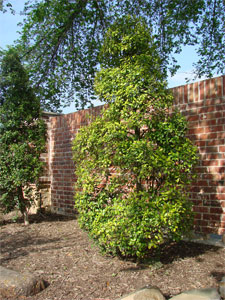
Question: We have a problem with a Foster’s holly (we’ve already lost one). It is turning yellow, and we do not know why. We have been told a lack of iron, so we gave it Ironite, which did not seem to help. Another person told us it was some type of bug attacking the plant. We tried using an insecticide, but it did not seem to help, either. Do you have any idea? D.R., no city given.
Answer: Oh, I so need to know where you are. Your e-mail gave your area code, so I’m assuming you’re in the Metroplex area, where soils are highly alkaline. Foster’s holly is poorly suited to alkaline, black clay soils, and iron deficiency is the eventual fate of the plants. That’s certainly what your photo indicates. However, it’s very difficult to get enough iron into these hollies to make any difference. Savannah holly is just as bad, if not worse. Your best option, if my assumptions are correct, would be to substitute a Nellie R. Stevens holly. It gets this tall and performs wonderfully.
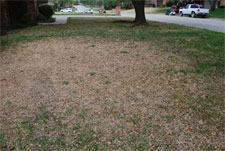
Question: Much of my yard is not coming in like the rest. I’m wondering if it is fungus related? Many of the runners are bare, and I don’t know if I will need to re-sod. P.C., Hurst.
Answer: I’m getting all kinds of calls on this very same issue, so if it’s any consolation, you’re certainly not alone. Your lawn looks like a combination of winter damage and Take All Root Rot. In fairness, however, this was taken several weeks ago, so it’s possible that the lawn looks better by now. I can offer help with TARR at my website.
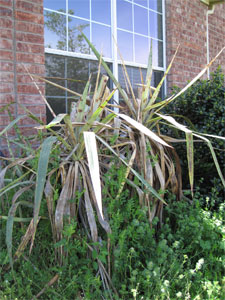
Question: I planted yuccas across the front of my house four years ago, because I wanted heat-tolerant, low-maintenance plants. Some have done well, but some look like the photo I’ve attached. (Spring weeds around them will die off when it gets hot.) Will the yuccas come back, or should I replace them? If the latter, should I plant more yuccas, or something else? J.T., Denton County.
Answer: It’s only one guy’s opinion, but there are much better-adapted plants for Denton County than yuccas. This is the problem with taking a plant that is native to one part of Texas and moving it to another place with vastly different environmental circumstances. My vote would be to go with other types of heat- and drought-tolerant plants that are able to withstand two or three weeks of wet, rainy weather and waterlogged soils. Let a nurseryman show you the best hollies, nandinas, junipers and crape myrtles for your needs. Purple wintercreeper euonymus groundcover would prevent the weeds from being a problem. Sure, you’d have a little maintenance once in a while, but the rewards would be wonderful. Oh, to answer about your yuccas: it appears they have suffered a combination of cold damage and a fungal leaf spot. I’m not sure which caused the greater part of the problem.
Question: This is the first year we have been invaded like this. The lawn is three years old and the Aristocrat Pears are 10 to 12 years old. I think I know what I have, but I’m not sure. Do you think mowing will take care of it, or should I put out some broadleaf treatment? Oh, yes — I put out pre-emergent March 5 for broadleaf. G.P., Denton.
Answer: Best guess from this side is that you have tons of root sprouts coming up from the pear’s root system. Since Aristocrat is a grafted variety, sprouts from its roots won’t be the same as the Aristocrat top. To confirm that’s what these are, dig up a few. They should be tethered to the mother tree with umbilical roots. Mowing would discourage them, and it’s your only way to do so while they’re a part of the main tree. If they’re seedlings of some other type of plant (not likely due to the area-wide distribution your distant photo shows), you could apply a broadleafed weedkiller spray to them carefully. Pre-emergent weedkillers won’t help with this problem.

